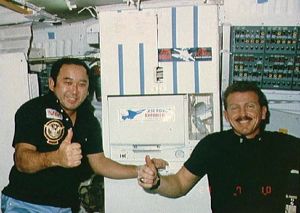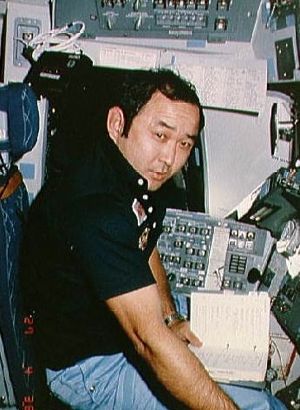
Home - Search - Browse - Alphabetic Index: 0- 1- 2- 3- 4- 5- 6- 7- 8- 9
A- B- C- D- E- F- G- H- I- J- K- L- M- N- O- P- Q- R- S- T- U- V- W- X- Y- Z
Onizuka, Ellison Shoji
 Onizuka Credit: www.spacefacts.de |
Status: Deceased; Active 1978-1986. Born: 1946-06-24. Died: 1986-01-28. Spaceflights: 2 . Total time in space: 3.07 days. Birth Place: Kealakekua, Kona, Hawaii.
Educated Colorado.
Official NASA Biography as of June 2016:Ellison S. Onizuka (Colonel, USAF)
NASA Astronaut (Deceased)
PERSONAL DATA: Born June 24, 1946, in Kealakekua, Kona, Hawaii. Died January 28, 1986. He is survived by his wife, Lorna, and two daughters. He enjoyed running, hunting, fishing, and indoor/outdoor sports.
EDUCATION: Graduated from Konawaena High School, Kealakekua, Hawaii, in 1964; received bachelor and master of science degrees in Aerospace Engineering in June and December 1969, respectively, from the University of Colorado.
ORGANIZATIONS: Member of the Society of Flight Test Engineers, the Air Force Association, the American Institute of Aeronautics and Astronautics, Tau Beta Pi, Sigma Tau, and the Triangle Fraternity.
AWARDS / PROMOTIONS: Posthumously promoted to the rank of Colonel. Posthumously awarded the Congressional Space Medal of Honor.
SPECIAL HONORS: Presented the Air Force Commendation Medal, Air Force Meritorious Service Medal, Air Force Outstanding Unit Award, Air Force Organizational Excellence Award, and National Defense Service Medal.
EXPERIENCE: Onizuka entered on active duty with the United States Air Force in January 1970 after receiving his commission at the University of Colorado through the 4-year ROTC program as a distinguished military graduate. As an aerospace flight test engineer with the Sacramento Air Logistics Center at McClellan Air Force Base, California, he participated in flight test programs and systems safety engineering for the F-84, F-100, F-105, F-111, EC-121T, T-33, T-39, T-28, and A-1 aircraft. He attended the USAF Test Pilot School from August 1974 to July 1975, receiving formal academic and flying instruction in performance, stability and control, and systems flight testing of aircraft. In July 1975, he was assigned to the Air Force Flight Test Center at Edwards Air Force Base, California, serving on the USAF Test Pilot School staff initially as squadron flight test engineer and later as chief of the engineering support section in the training resources branch. His duties involved instruction of USAF Test Pilot School curriculum courses and management of all flight test modifications to general support fleet aircraft (A-7, A-37, T-38, F-4, T-33, and NKC-135) used by the test pilot school and the flight test center. He has logged more than 1,700 hours flying time.
NASA EXPERIENCE: Selected as an astronaut candidate by NASA in January 1978, he completed a 1-year training and evaluation period in August 1979. He subsequently worked on orbiter test and checkout teams and launch support crews at the Kennedy Space Center for STS-1 and STS-2. He worked on software test and checkout crew at the Shuttle Avionics and Integration Laboratory (SAIL), and has supported numerous other technical assignments ranging from astronaut crew equipment/orbiter crew compartment coordinator to systems and payload development.
He first flew as a mission specialist on STS 51-C, the first Space Shuttle Department of Defense mission, which launched from Kennedy Space Center, Florida on January 24, 1985. He was accompanied by Captain Thomas K. Mattingly (spacecraft commander), Colonel Loren J. Shriver (pilot), fellow mission specialist, Colonel James F. Buchli, and Lieutenant Colonel Gary E. Payton (DOD payload specialist). During the mission Onizuka was responsible for the primary payload activities, which included the deployment of a modified Inertial Upper Stage (IUS). STS 51-C Discovery completed 48 orbits of the Earth before landing at Kennedy Space Center, Florida, on January 27, 1985. With the completion of this flight he logged a total of 74 hours in space.
Colonel Onizuka was a mission specialist on STS 51-L which was launched from the Kennedy Space Center, Florida, at 11:38:00 EST on January 28, 1986. The crew on board the Orbiter Challenger included the spacecraft commander, Mr. F.R. Scobee, the pilot, Commander M.J. Smith (USN), fellow mission specialists, Dr. R.E. McNair, and Dr. J.A. Resnik, as well as two civilian payload specialists, Mr. G.B. Jarvis and Mrs. S. C. McAuliffe. The STS 51-L crew died on January 28, 1986 when Challenger exploded 1 min. 13 sec. after launch.
JANUARY 2007
Official NASA Biography
Ellison S. Onizuka, was born in Kealakekua, Kona, Hawaii, on June 24, 1946, of Japanese-American parents. He attended the University of Colorado, receiving B.S. and M.S. degrees in engineering in June and December 1969, respectively. While at the university he married Lorna Leido Yoshida of Hawaii, and the couple eventually had two children. He also participated in the Air Force R.O.T.C. program, leading to a commission in January 1970. Onizuka served on active duty with the Air Force until January 1978 when he was selected as a NASA astronaut. With the Air Force in the early 1970s he was an aerospace flight test engineer at the Sacramento Air Logistics Center. After July 1975 he was assigned to the Air Force Flight Test Center at Edwards Air Force Base, California, as squadron flight test officer and later as chief of the engineering support section.
When Onizuka was selected for the astronaut corps he entered into a one year training program and then became eligible for assignment as a mission specialist on future Space Shuttle flights. He worked on orbiter test and checkout teams and launch support crews at the Kennedy Space Center for the first two Shuttle missions. Since he was an Air Force officer on detached duty with NASA, Onizuka was a logical choice to serve on the first dedicated Department of Defense classified mission. He was a mission specialist on STS-51-C, taking place 24-27 Jan. 1985 on the Discovery orbiter. The Challenger flight on which he was killed was his second Shuttle mission.
More at: Onizuka.
Family: Astronaut. Country: USA. Flights: STS-10, STS-41-E, STS-51-C, STS-51-L. Projects: STS. Agency: USAF. Bibliography: 12, 5852.
 | STS-51-C Astronauts Onizuka and Shriver pose in middeck Credit: NASA |
 | STS-51-C Mission Specialist Ellison Onizuka seated at commander's station Credit: NASA |
 | STS-51-C Astronaut Ellison Onizuka eating with chopsticks on the middeck Credit: NASA |
1946 June 24 - .
- Birth of Ellison Shoji Onizuka - . Nation: USA. Related Persons: Onizuka. American test engineer mission specialist astronaut 1978-1986. Died in Challenger accident. 2 spaceflights, 3.1 days in space. Flew to orbit on STS-51C (1985)..
1978 January 16 - .
- NASA Astronaut Training Group 8 selected. - .
Nation: USA.
Related Persons: Bluford,
Brandenstein,
Buchli,
Coats,
Covey,
Creighton,
Fabian,
Fisher,
Gardner,
Gibson,
Gregory,
Griggs,
Hart,
Hauck,
Hawley,
Hoffman,
Lucid,
McBride,
McNair,
Mullane,
Nagel,
Nelson,
Onizuka,
Resnik,
Ride,
Scobee,
Seddon,
Shaw,
Shriver,
Stewart,
Sullivan.
The group was selected to provide pilot, engineer, and scientist astronauts for space shuttle flights. Recruit women and minorities to introduce diversity into the astronaut corps. Qualifications: Pilots: Bachelor's degree in engineering, biological science, physical science or mathematics. Advanced degree desirable. At least 1,000 flight-hours of pilot-in-command time. Flight test experience desirable. Excellent health. Vision minimum 20/50 uncorrected, correctable to 20/20 vision; maximum sitting blood pressure 140/90. Height between 163 and 193 cm.
Mission Specialists: Bachelor's degree in engineering, biological science, physical science or mathematics and minimum three years of related experience or an advanced degree. Vision minimum 20/150 uncorrected, correctable to 20/20. Maximum sitting blood pressure of 140/90. Height between 150 and 193 cm.. 8,079 applicants, of which half met the basic qualifications. 208 invited for physical tests and interviews. Of the 35 selected, six were women, three were male African-Americans, and one was a male Asian-American.
1983 November - .
- STS-10 (cancelled) - . Crew: Buchli, Mattingly, Onizuka, Payton, Shriver. Backup Crew: Wright, Keith. Payload: DoD Mission. Nation: USA. Program: STS. Flight: STS-10. Planned Department of Defense shuttle mission. Cancelled due to payload delays..
1984 July - .
- STS-41-E (cancelled) - . Crew: Buchli, Detroye, Mattingly, Onizuka, Shriver. Backup Crew: Sundberg. Support Crew: Watterson. Payload: DoD Mission. Nation: USA. Program: STS. Flight: STS-41-E. Spacecraft Bus: Shuttle. Spacecraft: Challenger. Planned Department of Defense shuttle mission. Cancelled due to IUS failure..
1985 January 24 - . 19:50 GMT - . Launch Site: Cape Canaveral. Launch Complex: Cape Canaveral LC39A. Launch Platform: MLP1. LV Family: Shuttle. Launch Vehicle: Space Shuttle.
- STS-51-C - .
Call Sign: Discovery. Crew: Buchli,
Mattingly,
Onizuka,
Payton,
Shriver.
Payload: Discovery F03 / Magnum 1 [IUS]. Mass: 116,884 kg (257,685 lb). Nation: USA.
Related Persons: Buchli,
Mattingly,
Onizuka,
Payton,
Shriver.
Agency: NASA Houston.
Program: STS.
Class: Manned.
Type: Manned spaceplane. Flight: STS-51-C.
Spacecraft Bus: Shuttle.
Spacecraft: Discovery.
Duration: 3.06 days. Decay Date: 1985-01-27 . USAF Sat Cat: 15496 . COSPAR: 1985-010A. Apogee: 341 km (211 mi). Perigee: 332 km (206 mi). Inclination: 28.40 deg. Period: 91.30 min.
Manned five crew. Deployed USA 8 (Aquacade ELINT spacecraft). Orbits of Earth: 48. Landed at: Runway 15 at Kennedy Space Center, Florida. Landing Speed: 342 kph. Touchdown miss distance: 839.00 m. Landing Rollout: 2,240.00 m. Payloads: Department of Defence classified payloads.
1985 January 27 - .
- Landing of STS-51-C - . Return Crew: Buchli, Mattingly, Onizuka, Payton, Shriver. Nation: USA. Related Persons: Buchli, Mattingly, Onizuka, Payton, Shriver. Program: STS. Flight: STS-51-C. STS-51-C landed at 21:28 GMT. .
1986 January 28 - .
- Death of Ellison Shoji Onizuka. - . Related Persons: Onizuka. American test engineer mission specialist astronaut 1978-1986. Died in Challenger accident. 2 spaceflights, 3.1 days in space. Flew to orbit on STS-51C (1985)..
1986 January 28 - . 16:38 GMT - . Launch Site: Cape Canaveral. Launch Complex: Cape Canaveral LC39B. Launch Platform: MLP2. LV Family: Shuttle. Launch Vehicle: Space Shuttle. FAILURE: Seal on SRB failed, allowed hot gas to burn through External Tank.. Failed Stage: 0.
- STS-51-L - . Call Sign: Challenger. Crew: Jarvis, McAuliffe, McNair, Onizuka, Resnik, Scobee, Smith. Payload: Challenger F10 / TDRS 2 [IUS]. Mass: 116,670 kg (257,210 lb). Nation: USA. Related Persons: Jarvis, McAuliffe, McNair, Onizuka, Resnik, Scobee, Smith. Agency: NASA. Program: STS. Class: Manned. Type: Manned spaceplane. Flight: STS-51-L. Spacecraft Bus: Shuttle. Spacecraft: Challenger. Duration: 0.0008 days. Decay Date: 1986-01-28 . Apogee: 15 km (9 mi). Exploded 73 seconds after launch, all 7 crewmembers were killed; carried TDRSS satellite..
Back to top of page
Home - Search - Browse - Alphabetic Index: 0- 1- 2- 3- 4- 5- 6- 7- 8- 9
A- B- C- D- E- F- G- H- I- J- K- L- M- N- O- P- Q- R- S- T- U- V- W- X- Y- Z
© 1997-2019 Mark Wade - Contact
© / Conditions for Use